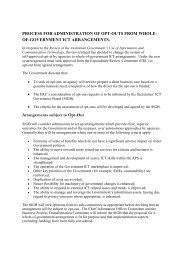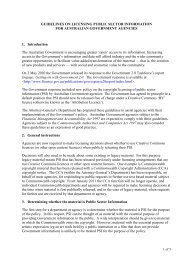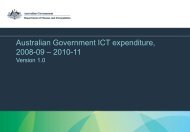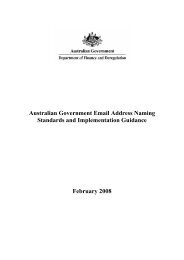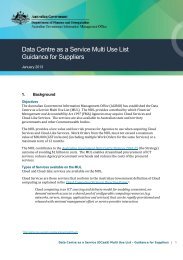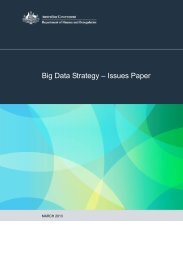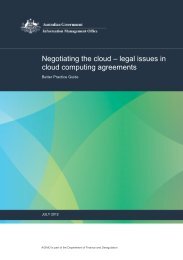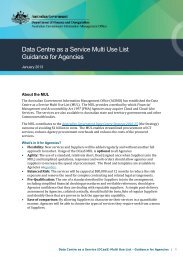A Guide to Implementing Cloud Services - Australian Government ...
A Guide to Implementing Cloud Services - Australian Government ...
A Guide to Implementing Cloud Services - Australian Government ...
Create successful ePaper yourself
Turn your PDF publications into a flip-book with our unique Google optimized e-Paper software.
A <strong>Guide</strong> <strong>to</strong> <strong>Implementing</strong> <strong>Cloud</strong><br />
<strong>Services</strong><br />
Better Practice <strong>Guide</strong><br />
SEPTEMBER 2012<br />
AGIMO is part of the Department of Finance and Deregulation
Disclaimer<br />
This document has been prepared by AGIMO in consultation with other agencies <strong>to</strong><br />
provide an overarching risk-managed approach for agencies <strong>to</strong> develop an<br />
organisational cloud strategy and implement cloud-based services.<br />
This document and the information contained herein are provided on an “as is”<br />
basis and the contribu<strong>to</strong>rs and the organisations they represent and are sponsored<br />
by disclaim all warranties, express or implied, including but not limited <strong>to</strong> any<br />
warranty that the use of the information herein will not infringe any rights or any<br />
implied warranties of merchantability or fitness for a particular purpose.<br />
Links <strong>to</strong> other websites are inserted for convenience only and do not constitute<br />
endorsement of material at those sites, or any associated organisation, product or<br />
service.<br />
© Commonwealth of Australia 2012<br />
Apart from any use permitted under the Copyright Act 1968, and the rights<br />
explicitly granted below, all rights are reserved.<br />
You are free <strong>to</strong> copy, distribute and transmit the work as long as you attribute the<br />
authors. You may not use this work for commercial purposes. You may not alter,<br />
transform, or build upon this work.<br />
Except where otherwise noted, any reference <strong>to</strong>, reuse or distribution of all or part<br />
of this report must include the following attribution:<br />
A <strong>Guide</strong> <strong>to</strong> <strong>Implementing</strong> <strong>Cloud</strong> <strong>Services</strong>, Copyright <strong>Australian</strong> <strong>Government</strong> 2012.<br />
Licence: This document is licensed under a Creative Commons Attribution Non-<br />
Commercial No Derivs 3.0 licence.<br />
To view a copy of this licence, visit: http://creativecommons.org/licenses/by-ncnd/3.0/legalcode.<br />
Any of the above conditions can be waived if you get our permission. Requests for<br />
permission should be addressed in the first instance <strong>to</strong> aga@finance.gov.au<br />
AGIMO is part of the Department of Finance and Deregulation
Contents<br />
Contents 3<br />
1. Introduction 4<br />
2. Identifying cloud opportunities 5<br />
2.1 Assess suitability against business needs 6<br />
2.2 Consider timing and triggers 8<br />
2.3 Consider financial impacts 8<br />
2.4 Consider organisational capability 8<br />
2.5 Manage change 9<br />
2.6 Review governance 9<br />
3. <strong>Implementing</strong> a cloud solution 10<br />
3.1 Build a business model 10<br />
3.2 Assess the risks 11<br />
3.3 Capture requirements 11<br />
3.4 Build a business case 14<br />
3.5 Prepare an exit strategy 15<br />
3.6 Determine contractual terms 15<br />
3.7 Approach the market 15<br />
3.8 Select a provider 16<br />
3.9 Plan for implementation and on-going operations 17<br />
4. Review the implementation 18<br />
Attachment 1 – <strong>Cloud</strong> business management checklist 19<br />
Attachment 2 – Business case template for a cloud solution 21<br />
AGIMO is part of the Department of Finance and Deregulation
1. Introduction<br />
The <strong>Australian</strong> <strong>Government</strong>’s policy on cloud computing is that agencies may choose<br />
<strong>to</strong> use cloud computing services where they provide value for money and adequate<br />
security, as stated in the April 2011 <strong>Australian</strong> <strong>Government</strong> <strong>Cloud</strong> Computing<br />
Strategic Direction Paper 1 (the Strategic Direction Paper).<br />
Readers new <strong>to</strong> cloud computing should read the Strategic Direction Paper which<br />
provides an introduction <strong>to</strong> cloud computing, a definition and an overview of its<br />
associated risks and benefits as they apply <strong>to</strong> <strong>Australian</strong> <strong>Government</strong> agencies.<br />
The guide supports the Strategic Direction Paper and provides an overarching riskbased<br />
approach for agencies <strong>to</strong> develop an organisational cloud strategy and<br />
implement cloud-based services. It is designed as an aid for experienced business<br />
strategists, architects, project managers, business analysts and IT staff <strong>to</strong> realise the<br />
benefits of cloud computing technology while managing risks.<br />
Agencies should use this guide <strong>to</strong> understand the issues surrounding moving<br />
services <strong>to</strong> the cloud. It focuses on activities <strong>to</strong> identify and implement cloud<br />
opportunities, and points <strong>to</strong> the following better practice guides where appropriate:<br />
1. Defence Signals Direc<strong>to</strong>rate’s <strong>Cloud</strong> Computing Security Considerations 2 ;<br />
2. National Archives of Australia’s Records Management in the <strong>Cloud</strong> 3 ;<br />
3. AGIMO’s Privacy and <strong>Cloud</strong> Computing for <strong>Australian</strong> <strong>Government</strong> Agencies 1 ;<br />
4. AGIMO’s Negotiating the cloud – legal issues in cloud computing agreements 1 ;<br />
5. AGIMO’s Financial Considerations for <strong>Government</strong> Use of <strong>Cloud</strong> Computing 1 ; and<br />
6. AGIMO’s Community <strong>Cloud</strong> Governance – An <strong>Australian</strong> <strong>Government</strong> perspective 1 .<br />
The guide contains the following major sections:<br />
Section 2 outlines consideration for agencies <strong>to</strong> identify opportunities <strong>to</strong> benefit<br />
from cloud-based services, which they can incorporate in<strong>to</strong> their ICT strategy. The<br />
following key areas are covered: suitability <strong>to</strong> business needs, timing and triggers,<br />
financial impacts, organisational capability and governance.<br />
Section 3 provides implementation guidance across the lifecycle of a cloud solution<br />
project. The section addresses business analysis, risk management, business case<br />
development, procurement, solution implementation and transition <strong>to</strong> operation.<br />
Section 4 provides a short list of post-implementation activities for agencies <strong>to</strong><br />
consider.<br />
Attachments include a checklist which follows the layout of this guide and a<br />
business case template for cloud solutions.<br />
1 http://www.finance.gov.au/e-government/strategy-and-governance/cloud-computing.html<br />
2 http://www.dsd.gov.au/infosec/cloudsecurity.htm<br />
3 http://www.naa.gov.au/records-management/agency/secure-and-s<strong>to</strong>re/rm-and-the-cloud<br />
A <strong>Guide</strong> <strong>to</strong> <strong>Implementing</strong> <strong>Cloud</strong> <strong>Services</strong> | 4
2. Identifying cloud opportunities<br />
The Strategic Direction Paper provides high-level direction for using cloud-based<br />
services across the <strong>Australian</strong> <strong>Government</strong>. It also highlights the many benefits <strong>to</strong><br />
be offered by cloud-based services, such as increased scalability, flexibility,<br />
availability and productivity. While cloud-based services share similarities with<br />
other service delivery models, e.g. managed services, they also offer their own<br />
unique opportunities, complexities and risks.<br />
A coordinated approach between business and ICT managers is needed <strong>to</strong> identify<br />
opportunities <strong>to</strong> benefit from cloud-based services. The approach taken includes the<br />
following considerations:<br />
<br />
<br />
<br />
<br />
<br />
<br />
<br />
<br />
benefiting from other agency or whole-of-government cloud initiatives;<br />
alignment with the agency’s business, ICT and information security strategy and<br />
policies;<br />
timing and triggers, such as planned system replacements or emerging business<br />
requirements;<br />
impacts on capital and operational expenditure;<br />
the ease with which staff members can sign-up and use cloud-based services, e.g.<br />
free basic services, without the requisite approvals or controls;<br />
the <strong>Australian</strong> <strong>Government</strong>’s strategic direction on cloud computing and open<br />
government (Gov 2.0) 4 ;<br />
the complexity of integrating cloud-based services with existing processes and<br />
technology; and<br />
the risks associated with s<strong>to</strong>ring and processing information in the cloud, e.g.<br />
security and service provision lock-in.<br />
Like any new delivery model, a first step is <strong>to</strong> target low risk, low value applications<br />
or pilots from which the organisation can measure actual costs and benefits, gain<br />
insights and draw lessons for future endeavours. The Strategic Direction Paper<br />
encourages agencies <strong>to</strong> adopt public cloud-based services for public facing<br />
“unclassified” government services and <strong>to</strong> undertake proof of concept studies <strong>to</strong><br />
fully understand the risks of cloud computing.<br />
Agencies should develop a coordinated approach <strong>to</strong> cloud-based services as an<br />
integral component of their ICT strategy and roadmap. Figure 1 shows the various<br />
inputs which agencies should consider as they develop such an approach. The<br />
following subsections offer guidance for each input area and point <strong>to</strong> details in the<br />
suite of better practice guides 1 where appropriate.<br />
4 http://www.finance.gov.au/e-government/strategy-and-governance/gov2.html<br />
A <strong>Guide</strong> <strong>to</strong> <strong>Implementing</strong> <strong>Cloud</strong> <strong>Services</strong> | 5
Business<br />
needs<br />
Timing and<br />
triggers<br />
Financial<br />
impacts<br />
<strong>Cloud</strong><br />
opportunities<br />
and risks<br />
Organisational<br />
capability<br />
Change<br />
management<br />
Governance<br />
Security<br />
Figure 1. Inputs <strong>to</strong> a cloud approach<br />
Support is available through the <strong>Cloud</strong> Information Community (CLIC), hosted by<br />
AGIMO. The CLIC serves <strong>to</strong> help agencies stay informed with developments in cloud<br />
policy and cloud-based services being used by other agencies. AGIMO strongly<br />
encourages agencies <strong>to</strong> provide details of cloud-based services and lessons learned<br />
<strong>to</strong> the CLIC so that other agencies can fac<strong>to</strong>r these in<strong>to</strong> their strategy and<br />
implementation programs.<br />
Agencies should also notify AGIMO at architecture@finance.gov.au when<br />
considering cloud-based services, per AGIMO Circular 2011/001 1 <strong>to</strong> help identify<br />
solutions that may contribute <strong>to</strong> whole-of-government initiatives.<br />
2.1 Assess suitability against business needs<br />
Agencies should identify the information types, services and associated business<br />
processes which stand <strong>to</strong> gain the most from cloud-based services and assess the<br />
impact of moving them <strong>to</strong> the cloud. The agency’s enterprise architecture will<br />
provide a useful place <strong>to</strong> start this analysis.<br />
2.1.1 Information<br />
From an information perspective, agencies maintain the same legislative and policy<br />
obligation <strong>to</strong> protect and manage information across the information lifecycle<br />
regardless of where it is s<strong>to</strong>red and processed. Such obligation includes compliance<br />
with the Protective Security Policy Framework (PSPF) 5 and the Information Security<br />
Manual (ISM) 6 . Agencies should take an information security management approach<br />
<strong>to</strong> determine which information sets <strong>to</strong> transition <strong>to</strong> cloud-based services. This<br />
includes assessing the business impact(s) that could result from the compromise,<br />
loss of, or disruption of access <strong>to</strong> information. The assessment should include the<br />
risk posed by data that has been aggregated. The Protective Security Governance<br />
5 http://www.protectivesecurity.gov.au/<br />
6 http://www.dsd.gov.au/infosec/ism/<br />
A <strong>Guide</strong> <strong>to</strong> <strong>Implementing</strong> <strong>Cloud</strong> <strong>Services</strong> | 6
<strong>Guide</strong>lines - Business Impact Levels 7 provides a common <strong>to</strong>ol <strong>to</strong> assist agencies <strong>to</strong><br />
assess the business impact for compromises of confidentiality, integrity or<br />
availability of individual or aggregated information, ICT systems and other assets.<br />
To assess the types and classifications of information that will best benefit from<br />
cloud-based services, agencies should consider the following fac<strong>to</strong>rs across the<br />
information lifecycle:<br />
<br />
<br />
<br />
<br />
<br />
<br />
<br />
<br />
<br />
<br />
<br />
potential adverse impact <strong>to</strong> the reputation of the <strong>Australian</strong> <strong>Government</strong>;<br />
potential impact <strong>to</strong> the governance of information, with particular reference <strong>to</strong><br />
ownership, stewardship and cus<strong>to</strong>dianship responsibilities;<br />
potential impact <strong>to</strong> an agency’s ability <strong>to</strong> develop flexible business processes<br />
that span one or more cloud-hosted solutions and possibly in-house hosted<br />
systems;<br />
potential impact <strong>to</strong> agency business processes if a business service or an IT<br />
services is transitioned <strong>to</strong> a cloud solution;<br />
potential impact <strong>to</strong> business continuity should a cloud solution no longer be<br />
available.<br />
ability <strong>to</strong> assure the availability, integrity and confidentiality of information<br />
(refer <strong>to</strong> <strong>Cloud</strong> Computing Security Considerations and Privacy and <strong>Cloud</strong><br />
Computing);<br />
potential impact <strong>to</strong> data formats and interoperability;<br />
impact on existing architecture and integration with existing systems;<br />
potential impact <strong>to</strong> data access, discovery, archival and destruction;<br />
the ability of the agency <strong>to</strong> maintain legislative and regula<strong>to</strong>ry compliance, e.g.<br />
with the Archives Act 1983 (refer <strong>to</strong> Records Management in the <strong>Cloud</strong>); and<br />
the cloud deployment model (i.e. public, private, community, hybrid) that would<br />
be most appropriate.<br />
2.1.2 <strong>Services</strong><br />
As part of determining which services are appropriate for the cloud, agencies should<br />
consider the business problem or opportunity. When evaluating which end-<strong>to</strong>-end<br />
business services are suitable for the cloud, agencies should consider the services<br />
that:<br />
<br />
<br />
<br />
<br />
<br />
<br />
<br />
<br />
have stable and consistent functional requirements;<br />
could be readily shared with other agencies with similar needs;<br />
have cyclical, seasonal or uncertain demand, and could benefit from added<br />
flexibility from the cloud;<br />
aren’t highly integrated with in-house applications or other processes;<br />
have data formats or portability requirements that are not critical;<br />
have manageable business continuity requirements;<br />
have discrete components of the end-<strong>to</strong>-end business process that can be<br />
transitioned <strong>to</strong> the cloud, e.g. public-facing workflows; and<br />
have functional requirements that could be met by cloud-based services.<br />
7 http://www.protectivesecurity.gov.au/governance/security-risk-management/Pages/Supporting-guidelines-for-securityrisk-management.aspx<br />
A <strong>Guide</strong> <strong>to</strong> <strong>Implementing</strong> <strong>Cloud</strong> <strong>Services</strong> | 7
With an understanding of which information, services and business processes that<br />
would benefit most from cloud-based services, agencies should assess the technical<br />
barriers they will have <strong>to</strong> address. Fac<strong>to</strong>rs such as impacts <strong>to</strong> existing infrastructure,<br />
e.g. bandwidth, and enterprise applications apply <strong>to</strong> even the simplest cloud-based<br />
services. Hybrid cloud-based services that integrate with in-house software services<br />
will require an in-depth investigation in<strong>to</strong> technical issues such as service<br />
orchestration, programming interfaces, data format standards and latency.<br />
2.2 Consider timing and triggers<br />
An agency’s architectural roadmap and project portfolio will provide useful <strong>to</strong>ols <strong>to</strong><br />
identify the timing and trigger points that present opportunities for the use of cloudbased<br />
services. Agencies should consider:<br />
<br />
<br />
<br />
<br />
<br />
business and IT systems scheduled for replacement;<br />
planned system implementations/upgrades;<br />
requirements for system development/testing where cloud infrastructure could<br />
be used;<br />
pilots, time-bound or short lifespan projects; and<br />
capabilities used only periodically.<br />
Agencies should also seek opportunities <strong>to</strong> develop/adopt cross-agency or portfolio<br />
cloud-based services and/or build on initiatives established by other agencies.<br />
AGIMO provides assistance <strong>to</strong> agencies in finding shared resource solutions and can<br />
be contacted at architecture@finance.gov.au.<br />
2.3 Consider financial impacts<br />
The transition <strong>to</strong> cloud-based services will have financial and budgetary impacts<br />
that agencies must consider at strategic and operational levels. While cloud-based<br />
services have the potential <strong>to</strong> reduce capital expenditure, agencies will have <strong>to</strong><br />
consider the impacts on their budgets and financial statements.<br />
Any impacts will need <strong>to</strong> be reflected in the agency’s financial statements. Any<br />
reduction in capital spending will need <strong>to</strong> be reflected in the agency’s capital<br />
management plan. Refer <strong>to</strong> Financial Considerations for <strong>Government</strong> Use of <strong>Cloud</strong><br />
Computing for more detailed coverage of this <strong>to</strong>pic.<br />
2.4 Consider organisational capability<br />
The management of cloud-based services requires capabilities similar <strong>to</strong> that used in<br />
typical outsourcing arrangements. That is, agencies will require well-developed<br />
skills in project and program management, relationship management, procurement<br />
and contract management, and services provisioning and management. Agencies<br />
will also need <strong>to</strong> understand workflow design, cloud architecture and capacity<br />
management. Agencies that do not have mature capability in these areas should take<br />
a gradual approach <strong>to</strong> moving <strong>to</strong> cloud-based services while they develop that<br />
maturity. For example, a lack of service management maturity may lead <strong>to</strong><br />
challenges for the management of service and performance, as with any outsourced<br />
arrangement.<br />
<strong>Cloud</strong>-based services may require new skills. There may be a decreased need for<br />
specialist operation and support skills depending on the nature of the cloud<br />
A <strong>Guide</strong> <strong>to</strong> <strong>Implementing</strong> <strong>Cloud</strong> <strong>Services</strong> | 8
solution, but there will also be a need for additional contract management<br />
capabilities.<br />
The agency should also have mature capabilities in the areas of enterprise<br />
architecture and business analysis <strong>to</strong> assess and manage changes <strong>to</strong> its architecture<br />
and business processes. A cloud solution will not fix immature business processes or<br />
cultural issues.<br />
Agencies should consider the strategic impact that their approach <strong>to</strong> cloud-based<br />
services will have on their organisation structure and skills sets, and implement a<br />
plan <strong>to</strong> mature capabilities in targeted areas.<br />
2.5 Manage change<br />
Agencies can improve the likelihood of successful adoption and user take-up of<br />
cloud-based services by actively keeping stakeholders informed and addressing<br />
their concerns. Stakeholder concerns may include:<br />
<br />
<br />
<br />
<br />
<br />
<br />
s<strong>to</strong>ring information in the cloud;<br />
uncertainty with new technology;<br />
shifting staff roles;<br />
increased dependence on a third party;<br />
the possibility of deterioration of cus<strong>to</strong>mer care or service quality; and<br />
loss of control.<br />
Agencies should establish a stakeholder engagement plan, obtain senior executive<br />
sponsorship and work closely with key stakeholders <strong>to</strong> ensure they are kept<br />
informed throughout.<br />
2.6 Review governance<br />
Well-defined, effective governance is essential for cloud computing. Agencies should<br />
review their governance model <strong>to</strong> ensure the structure, guidance and controls are<br />
adequate. Agencies should consider new or changed roles and responsibilities, such<br />
as the addition of CSPs and partner agencies for community clouds.<br />
In the case of community clouds, the lead agency may need <strong>to</strong> review existing<br />
memorandums of understanding and establish a cloud computing agreement. The<br />
Better Practice <strong>Guide</strong>: Community <strong>Cloud</strong> Governance – An <strong>Australian</strong> <strong>Government</strong><br />
perspective provides specific guidance on developing governance for community<br />
clouds and includes a sample governance structure. The information provided in<br />
this guide may translate <strong>to</strong> other cloud models.<br />
A <strong>Guide</strong> <strong>to</strong> <strong>Implementing</strong> <strong>Cloud</strong> <strong>Services</strong> | 9
3. <strong>Implementing</strong> a cloud solution<br />
Implementation activities for a cloud solution are similar <strong>to</strong> that of an outsourced<br />
solution. That is, the agency will have <strong>to</strong> conduct business analysis, build a business<br />
case, source a cloud service provider (CSP), plan and implement the solution,<br />
possibly with the assistance of a third-party system integra<strong>to</strong>r. This section provides<br />
advice across the lifecycle of a cloud solution project with the aim of ensuring the<br />
cloud solution will:<br />
<br />
<br />
<br />
<br />
<br />
meet business needs in terms of both functionality and performance;<br />
provide the expected efficiencies and benefits;<br />
adequately protect agency information;<br />
comply with legislative and regula<strong>to</strong>ry requirements; and<br />
integrate with existing processes and systems.<br />
3.1 Build a business model<br />
The work <strong>to</strong> develop an agency’s approach <strong>to</strong> cloud-based services will provide the<br />
business context required for candidate cloud-based services. Business analysis<br />
activities will be similar <strong>to</strong> those used for an outsourced solution. Such activities<br />
include building a business model and gathering requirements <strong>to</strong> form the basis for<br />
the business case, sourcing, implementation and testing.<br />
The business model will help the agency determine performance and resource<br />
requirements, lifecycle cost estimation, and required risk treatment measures.<br />
Agencies should consider how they would respond <strong>to</strong> business continuity and<br />
disaster recover scenarios, such as cloud service disruption or cancellation. These<br />
scenarios can later be developed in<strong>to</strong> requirements and plans.<br />
The <strong>Australian</strong> <strong>Government</strong> Architecture Reference Models 8 , in particular the<br />
Performance Reference Model, can be used <strong>to</strong> identify and define measures <strong>to</strong><br />
quantify resource utilisation, costs attributed <strong>to</strong> business process execution and<br />
costs <strong>to</strong> promote the use of output by cus<strong>to</strong>mers.<br />
The business model must have sufficient detail <strong>to</strong> estimate cost in terms which can<br />
be applied <strong>to</strong> the CSP’s cost model. For infrastructure as a service (IaaS) and<br />
platform as a service (PaaS), this might be measured in resource usage per period of<br />
time, as for processing, throughput and s<strong>to</strong>rage. For software as a service (SaaS),<br />
service might be measured by number of transactions or number of users.<br />
With an understanding of which resources <strong>to</strong> measure, business analysts should<br />
model expected utilisation and potential surge scenarios by considering:<br />
<br />
<br />
user characteristics, e.g. user types/roles, number of users, usage scenarios;<br />
data characteristics, e.g. data types, size and quantity;<br />
8 http://www.finance.gov.au/e-government/strategy-and-governance/australian-government-architecture.html<br />
A <strong>Guide</strong> <strong>to</strong> <strong>Implementing</strong> <strong>Cloud</strong> <strong>Services</strong> | 10
average usage rates, e.g. transactions per second<br />
how usage rates will vary, e.g. upper and lower ranges;<br />
where can changes <strong>to</strong> usage rates be predicted, either at planned times or based<br />
on events;<br />
how usage will grow or scale over time, perhaps with the number of users; and<br />
how usage will change for each system ac<strong>to</strong>r, e.g. end user, administra<strong>to</strong>r, batch<br />
processes.<br />
Where possible, agencies should validate the model either by comparison <strong>to</strong> existing<br />
systems, with a benchmarking program, or by piloting a solution. <strong>Cloud</strong>-based<br />
services may provide better value for short-term or burst use, but a non-cloud<br />
solution may provide more value over the long term, particularly for services with<br />
steady loads.<br />
3.2 Assess the risks<br />
Agencies should use the business model <strong>to</strong> undertake an initial threat and risk<br />
assessment (TRA). The PSPF states that agencies must apply a principles and riskbased<br />
approach <strong>to</strong> all areas of protective security activity across their organisation<br />
including service provider selection, in accordance with:<br />
<br />
<br />
AS/NZS ISO 31000:2009 – Risk Management, Principles and <strong>Guide</strong>lines; and<br />
HB 167:2006 Security Risk Management.<br />
The other cloud computing better practice guides are a useful resource for agencies<br />
<strong>to</strong> help identify risks and determine suitable treatment strategies. Agencies should<br />
also consider the cost <strong>to</strong> manage the associated risks and its impact on the value<br />
proposition.<br />
The following risk categories provide a useful start for identifying risks:<br />
<br />
<br />
<br />
<br />
<br />
<br />
<br />
Quality – does the cloud solution meet stakeholder needs;<br />
Financial – does the cloud solution provide value for money;<br />
Organisational – does the cloud solution work within the agency’s culture;<br />
Integration – can the cloud solution meet objectives without business or<br />
technical integration difficulties;<br />
Compliance – does the cloud solution comply with agency’s legal, regula<strong>to</strong>ry and<br />
policy obligations;<br />
Business Continuity – can the cloud solution recover from outages or disaster<br />
situation; and<br />
External – is the CSP performance adequate.<br />
3.3 Capture requirements<br />
The business model and risk assessment provide a basis for determining<br />
requirements. For each requirement, agencies should note which are manda<strong>to</strong>ry<br />
and which are desirable. It may be useful for agencies <strong>to</strong> use a standard practice<br />
description, such as the IT Infrastructure Library (ITIL), <strong>to</strong> ensure coverage of<br />
requirements which relate <strong>to</strong> the management of services.<br />
3.3.1 Functionality<br />
Functional requirements will differ according <strong>to</strong> the type of cloud service model:<br />
A <strong>Guide</strong> <strong>to</strong> <strong>Implementing</strong> <strong>Cloud</strong> <strong>Services</strong> | 11
For IaaS, requirements will relate <strong>to</strong> the provision of processing, memory,<br />
s<strong>to</strong>rage and operating systems. Agencies will need <strong>to</strong> consider:<br />
whether operating systems licence costs will be included in the solution or<br />
provided by the agency, and<br />
what open source options are available.<br />
For PaaS, requirements should specify both the development and operating<br />
environment.<br />
For SaaS, requirements will be similar <strong>to</strong> those of a non-cloud solution.<br />
Functional requirements should consider the ability <strong>to</strong> backup and res<strong>to</strong>re data or<br />
system images, whether it is the provider’s responsibility, and where backups will<br />
be s<strong>to</strong>red. They should also consider any bulk data transfer, either as a part of<br />
normal operation or as part of an exit strategy. Agencies should consider the options<br />
available <strong>to</strong> transfer data, including network or physical transfers, such as tape or<br />
disc packs.<br />
Lastly, agencies should consider any requirements <strong>to</strong> interoperate and/or integrate<br />
with in-house or back office systems, for example identity management and<br />
authentication systems.<br />
3.3.2 Standards<br />
Agencies will best achieve interoperability through the use of industry-recognised<br />
open standards. While cloud-based services are not a new technology, existing<br />
technology standards, programming interface standards and data formats may need<br />
<strong>to</strong> be amended and new standards implemented where necessary. For example,<br />
standards for configuration and management of cloud-based services are still<br />
maturing and tend <strong>to</strong> vary among CSPs.<br />
Standards for cloud computing are evolving locally through the work of Standards<br />
Australia and the national mirror committee of international working group SC 38,<br />
a subcommittee of the ISO/IEC Joint Technical Committee 1. Agencies should<br />
moni<strong>to</strong>r the development of international standards and adopt and apply them<br />
when available.<br />
Agencies will need <strong>to</strong> ensure that the appropriate levels of security, interoperability,<br />
and data portability are fac<strong>to</strong>red in<strong>to</strong> any architectural design work and in<strong>to</strong> any<br />
contractual arrangements. Conformance <strong>to</strong> standards must also be tested during the<br />
implementation of a cloud solution.<br />
3.3.3 Performance<br />
Performance requirements derive from the business model and from business<br />
impact analysis. Although business will measure performance from the user’s<br />
perspective, there are several fac<strong>to</strong>rs such as client-side processing and network<br />
delays which CSPs will be unable <strong>to</strong> control.<br />
Performance requirements, such as availability, reliability, recoverability,<br />
responsiveness and throughput are generally the same as for internal systems.<br />
Specific requirements <strong>to</strong> consider include:<br />
<br />
<br />
availability metrics include a unit of time, e.g. downtime per month;<br />
guaranteed maximum outages and outage durations if reliability is critical;<br />
A <strong>Guide</strong> <strong>to</strong> <strong>Implementing</strong> <strong>Cloud</strong> <strong>Services</strong> | 12
how much data can be lost and the minimum acceptable time <strong>to</strong> recover from<br />
both transient and catastrophic failures;<br />
both average and peak response times for various types of transactions; and<br />
the data size for transactions, and peaks and averages from the usage model.<br />
During procurement, agencies should define performance requirements and<br />
negotiate performance guarantees in contract. Refer <strong>to</strong> Section 3.6 Define<br />
contractual terms and Section 3.8 Select a provider for more details.<br />
3.3.4 Manageability<br />
There are several requirements <strong>to</strong> consider regarding the ability <strong>to</strong> configure and<br />
manage cloud-based services.<br />
Agencies should note that the ICT Cus<strong>to</strong>misation and Bespoke Development Policy 9<br />
applies <strong>to</strong> cloud-based services, particularly SaaS and PaaS where cus<strong>to</strong>misation<br />
may reduce the financial benefit for the agency.<br />
Agencies should consider the following requirements:<br />
<br />
<br />
<br />
<br />
the ability <strong>to</strong> provision resources (e.g. on-demand or self-service), the speed of<br />
provisioning and the ability <strong>to</strong> cap resources;<br />
the availability of reports that map <strong>to</strong> business objectives and provide objective<br />
measurement of business performance, e.g. billed resources, resource<br />
utilisation, throughput, availability and any other quality of service measures;<br />
the frequency, format and delivery of reports; and<br />
the ability <strong>to</strong> manage faults, including procedures <strong>to</strong> report and check on faults,<br />
reporting channels, and availability of support staff.<br />
CSPs will have differing service levels and capabilities <strong>to</strong> meet manageability<br />
requirements. Agencies should confirm that the CSP will have the ability <strong>to</strong> meet its<br />
requirements during the selection process.<br />
3.3.5 Security<br />
Security is a compulsory obligation as outlined in the PSPF and the ISM. Agencies<br />
must determine the level of security required by undertaking a risk assessment <strong>to</strong><br />
determine the business impact for each information set that is being considered for<br />
transition <strong>to</strong> a cloud solution. The security assessment should consider:<br />
<br />
<br />
<br />
<br />
<br />
<br />
authorisation, end-user access controls and provider access controls;<br />
authentication, encryption, key management;<br />
data location and the applicability of foreign laws, data separation/segregation,<br />
data destruction;<br />
logging and audit;<br />
threat management; and<br />
physical security.<br />
DSD has recommended that agencies undertake their risk assessments integrating<br />
the controls outlined in the <strong>Cloud</strong> Computing Security Considerations.<br />
9 http://www.finance.gov.au/e-government/strategy-and-governance/Whole-of-<strong>Government</strong>-ICT-Policies.html<br />
A <strong>Guide</strong> <strong>to</strong> <strong>Implementing</strong> <strong>Cloud</strong> <strong>Services</strong> | 13
3.3.6 Compliance<br />
Agencies should keep in mind their legislative and regula<strong>to</strong>ry obligations <strong>to</strong> keep<br />
data confidential or guarantee it’s not lost or destroyed. Many of these will translate<br />
in<strong>to</strong> specific security and requirements, or perhaps certification requirements.<br />
Key legislation includes Public Service Act 1999, Freedom of Information Act 1982,<br />
Privacy Act 1988, Archives Act 1983, Evidence Act 1995, Copyright Act 1968 and the<br />
Electronic Transactions Act 1999.<br />
There may be other policies, strategies and frameworks that a CSP will need <strong>to</strong><br />
comply with. Examples include:<br />
<br />
<br />
<br />
The <strong>Australian</strong> <strong>Government</strong>’s Department of Finance and Deregulation circulars<br />
and advice including whole of government ICT policies, strategies, frameworks<br />
and policies, for example, use of Internet-based Network Connections Service<br />
(IBNCS) panel for all wide area network and internet connections, internet<br />
gateway reduction program for all internet gateways;<br />
agency-specific procurement policies; and<br />
agency-specific security policies.<br />
Refer <strong>to</strong> Privacy and <strong>Cloud</strong> Computing for <strong>Australian</strong> <strong>Government</strong> Agencies, <strong>Cloud</strong><br />
Computing Security Considerations and Records Management in the <strong>Cloud</strong> for further<br />
guidance.<br />
3.4 Build a business case<br />
A sound business case provides an objective view of the business rationale, benefits,<br />
costs, risks and options involved with solving a business problem. It provides the<br />
justification for a cloud solution weighed against other alternatives, such as noncloud<br />
solutions. It also provides the basis for planning and implementing the<br />
solution. The business case justifies the appropriateness of the cloud solution and<br />
provides a reference point for re-evaluation at a future point in time, e.g. for changes<br />
<strong>to</strong> business requirements or emergence of new solutions in the marketplace.<br />
AGIMO provides an ICT Business Case <strong>Guide</strong>, templates and costing spreadsheet<br />
which are required as part of the ICT Two Pass Review process 10 for ICT-enabled<br />
proposals with:<br />
<br />
<br />
high risks in terms of technical complexity, workforce or schedule, and<br />
a <strong>to</strong>tal cost of $30 million, including an ICT cost of $10 million or more.<br />
For smaller initiatives, this guide provides a tailored version of the ICT Business<br />
Case Template as an attachment. The attachment provides specific guidance for<br />
developing a business case where a cloud solution is an option.<br />
This section should also be read in conjunction with the Financial Considerations for<br />
<strong>Government</strong> Use of <strong>Cloud</strong> Computing which provides further advice on assessing<br />
financial risks and preparing a financial assessment.<br />
The business case should begin with the rationale for adopting a cloud solution<br />
weighed against other alternatives. It should capture the business need, how the<br />
proposed adoption of a cloud computing solution meets that need, and how it aligns<br />
10 http://www.finance.gov.au/budget/ict-investment-framework/two-pass-review.html<br />
A <strong>Guide</strong> <strong>to</strong> <strong>Implementing</strong> <strong>Cloud</strong> <strong>Services</strong> | 14
with the agency’s sourcing strategy and architecture. Where this involves a move<br />
away from traditional investments in ICT infrastructure and <strong>to</strong> the adoption of a<br />
cloud solution, the rationale should support a specific business need.<br />
For each option, the business case should include an analysis of the cost model with<br />
identified costs, benefits, pricing model, contractual adjustments, variation <strong>to</strong><br />
contracts, and any changes in budgetary appropriation types. The level of detail<br />
provided for each option should be commensurate with its level of investment and<br />
risk.<br />
3.5 Prepare an exit strategy<br />
An exit strategy is critical for a cloud solution as it documents the agency’s<br />
contingency plan <strong>to</strong> migrate records securely <strong>to</strong> another solution, non-cloud or<br />
cloud, while maintaining business continuity. For data s<strong>to</strong>red by the CSP, the agency<br />
must also consider what data will need <strong>to</strong> be archived, where it will be archived, the<br />
method <strong>to</strong> transfer it, how it will be destroyed and how destruction will be verified<br />
<strong>to</strong>gether with the security requirements associated with these processes. Liabilities<br />
should be clearly defined in the contractual terms and cover breaches beyond the<br />
life of the contract. Agencies should review key requirements for data backup, bulk<br />
transfer and format standards as mentioned below under Functionality and<br />
Standards. Records Management in the <strong>Cloud</strong> also provides further guidance. The<br />
costs associated with the exit strategy should be accounted for in the cost model and<br />
the business case.<br />
The exit strategy must also consider the likely business scenarios that may be<br />
required. Scenarios could include the inability of the CSP <strong>to</strong> meet performance<br />
requirements, CSP security breaches or issues involving CSP business viability.<br />
3.6 Determine contractual terms<br />
Prior <strong>to</strong> approaching the market agencies should determine the contractual terms<br />
they will require, even when they anticipate a standardised ‘click wrap’ agreement<br />
<strong>to</strong> be the only option. A prior understanding of the agency’s terms will provide a<br />
basis <strong>to</strong> ensure the final contract will meet business requirements, security<br />
requirements and adequately address the risks associated with the cloud solution.<br />
Agencies should refer <strong>to</strong> Negotiating the cloud – legal issues in cloud computing<br />
agreements as a starting point for defining contractual terms. The guide details the<br />
contractual mechanisms <strong>to</strong> manage risks.<br />
3.7 Approach the market<br />
Agencies should determine the most appropriate model — for example, cloud<br />
computing, managed services, outsourcing, in-house delivery or hybrids of these —<br />
for the business problem being addressed.<br />
Agencies must meet the usual requirements that apply <strong>to</strong> procurement, including<br />
compliance with Commonwealth Procurement Rules (CPRs) and agency Chief<br />
Executive Instructions. Agencies must also comply with whole-of-government ICT<br />
coordinated procurement arrangements.<br />
A <strong>Guide</strong> <strong>to</strong> <strong>Implementing</strong> <strong>Cloud</strong> <strong>Services</strong> | 15
When drafting procurement documentation, agencies should consider the following<br />
areas:<br />
<br />
<br />
<br />
clearly define the business problem;<br />
outline the agency’s needs and constraints clearly — for example, what is the<br />
scope, the rationale behind moving <strong>to</strong> a cloud solution or indeed whether you go<br />
<strong>to</strong> the market for all types of solutions including a cloud solution; and<br />
are there any constraints surrounding legislation, regulation, legacy systems,<br />
integration, connectivity, availability, information security and integrity, etc.<br />
Agencies may choose <strong>to</strong> use the Data Centre as a Service (DCaaS) multi-use list<br />
(MUL) which will be available for use by agencies in November 2012. The aim of the<br />
MUL is <strong>to</strong> provide the smaller 50 percent of agencies with a means <strong>to</strong> identify<br />
potential suppliers of cloud and cloud-like services. The MUL may also be used by<br />
larger agencies, state and terri<strong>to</strong>ry governments and other Commonwealth bodies.<br />
The MUL will provide agencies with a common approach <strong>to</strong> sourcing solutions for<br />
contracts which are less than $80,000 and less than 12 months. To be included on<br />
the DCaaS MUL suppliers will have signed a deed giving agencies confidence that<br />
they are dealing with reputable suppliers. The DCaaS initiative will also incorporate<br />
post-delivery assessments (feedback) by agencies <strong>to</strong> help identify bona fide<br />
providers from those that have proven <strong>to</strong> lack the appropriate capabilities.<br />
3.8 Select a provider<br />
Like any procurement, selecting a CSP involves verifying that the business needs<br />
and security requirements are fully addressed in the contractual arrangements and<br />
that the outcome is based on the value for money principle.<br />
Agencies should validate the cost model against the CSP’s pricing considering the<br />
following:<br />
<br />
<br />
<br />
<br />
<br />
<br />
<br />
assure pricing is transparent, e.g. subscription or pay-as-you-go pricing,<br />
upgrades, maintenance and exit costs;<br />
costs for unexpected peaks in demand;<br />
require service price for upgrade and maintenance fees appropriate <strong>to</strong> the<br />
services being procured, some upgrades may be au<strong>to</strong>matic and included in the<br />
service;<br />
confirm the cost model is suitable and allows for scaling and changes <strong>to</strong> service;<br />
look for commitment requirements, such as minimum use;<br />
confirm setup, training and integration fees; and<br />
request references <strong>to</strong> clarify ongoing cost of service.<br />
In addition <strong>to</strong> the considerations in <strong>Cloud</strong> Computing Security Considerations,<br />
agencies should consider the following as they evaluate requirements:<br />
<br />
<br />
<br />
<br />
look for requirements which may not fit in<strong>to</strong> the CSP’s existing pre-configured<br />
templates and may increase the cost of configuration;<br />
confirm the CSP’s ability <strong>to</strong> meet service levels, noting the CSPs will likely have<br />
differing service level definitions and capabilities;<br />
confirm the ability <strong>to</strong> moni<strong>to</strong>r CSP service levels;<br />
confirm the CSP’s architecture will meet scalability, availability, capacity and<br />
performance guarantees and is sufficient for agency requirements;<br />
A <strong>Guide</strong> <strong>to</strong> <strong>Implementing</strong> <strong>Cloud</strong> <strong>Services</strong> | 16
confirm any multi-tenancy arrangements and their impact on security<br />
requirements;<br />
determine any foreign laws which may impact the CSP and the data it s<strong>to</strong>res;<br />
confirm where the CSP’s data will be located, including any transborder data<br />
transfer, if applicable;<br />
confirm the CSP’s willingness <strong>to</strong> allow audits, particularly in multi-tenancy<br />
arrangements; and<br />
confirm the CSP’s disaster recovery (DR) capability meets the agency’s<br />
requirements;<br />
if necessary, ask for proof that the supplier conducts DR exercises which<br />
confirm the ability <strong>to</strong> fail key production components <strong>to</strong> a secondary data<br />
centre with documented disaster recovery procedures, and<br />
key elements of proof include the ability <strong>to</strong> access <strong>to</strong> network, components<br />
and applications while maintaining data currency, and evidence of processes<br />
<strong>to</strong> keep DR plans, scripts and procedures reviewed and updated;<br />
3.9 Plan for implementation and on-going operations<br />
The planning required in a cloud solution implementation is similar <strong>to</strong> that of an<br />
outsourcing arrangement. Agencies will require an internal project <strong>to</strong> manage those<br />
activities which will need <strong>to</strong> be done in-house. Such activities typically include:<br />
<br />
<br />
<br />
<br />
<br />
<br />
<br />
prepara<strong>to</strong>ry work <strong>to</strong> make application and infrastructure ready for integration<br />
with the cloud solution;<br />
perform risk and security assessments;<br />
updating business continuity plans;<br />
preparing an end of life plan <strong>to</strong> disengage with the provider and transition<br />
service and data while assuring business continuity;<br />
updating architectural artefacts;<br />
performing acceptance testing; and<br />
managing business transition and organisational change.<br />
Agencies must also put in place the internal capability and resources need <strong>to</strong><br />
manage the cloud service on a daily basis. Ongoing operational activities include:<br />
<br />
<br />
<br />
<br />
<br />
<br />
<br />
<br />
<br />
moni<strong>to</strong>ring performance and service levels;<br />
responding <strong>to</strong> incidents and service disruptions;<br />
analysing, coordinating, prioritising and implementing configuration changes <strong>to</strong><br />
meet emerging requirements and user feedback;<br />
managing configuration documentation;<br />
coordinating planned upgrades or outages;<br />
reconciling invoices against services provided;<br />
managing the relationship with the CSP;<br />
administering governance arrangements; and<br />
handling service or contract disputes.<br />
Agencies will need <strong>to</strong> clearly define processes, procedures, roles and responsibilities<br />
for these activities, clearly specifying which tasks must be done in-house and which<br />
will be done by the CSP.<br />
Where changes <strong>to</strong> internal skills are required, agencies must ensure the necessary<br />
organisational changes are in place so sufficient in-house resources are in place <strong>to</strong><br />
meet the requirements for on-going operations.<br />
A <strong>Guide</strong> <strong>to</strong> <strong>Implementing</strong> <strong>Cloud</strong> <strong>Services</strong> | 17
4. Review the implementation<br />
Agencies should conduct a post-implementation review after the implementation <strong>to</strong>:<br />
undertake periodic risk assessments for information held in the cloud;<br />
compare the value and benefits of cloud solution against the business case;<br />
capture lessons learned from the implementation, operation and support of the<br />
cloud service;<br />
prioritise any new business changes; and<br />
provide feedback through AGIMO and the CLIC <strong>to</strong> other government agencies.<br />
A <strong>Guide</strong> <strong>to</strong> <strong>Implementing</strong> <strong>Cloud</strong> <strong>Services</strong> | 18
Attachment 1 – <strong>Cloud</strong> business<br />
management checklist<br />
Agencies should use this checklist in conjunction with the recommendations<br />
provided in the guide. The left column indicates the related section. By<br />
acknowledging the completion of items in this checklist, the user confirms the<br />
consideration of all advice provided in the guide.<br />
Establish strategic direction which begins with low risk applications or pilots and<br />
draws on lessons learned for future endeavours <strong>to</strong> capitalise on potential benefits of<br />
cloud-based services<br />
2 Engage with the AGIMO and the <strong>Cloud</strong> Information Community <strong>to</strong> identify<br />
opportunities<br />
2.1 Assess suitable business needs <strong>to</strong> determine which information types and<br />
business processes will benefit the most from cloud-based services and their<br />
related technical impacts<br />
2.2 Consider triggers and timing, identifying upcoming initiatives which present<br />
opportunities for the use of cloud-based services<br />
2.3 Consider financial impacts, including whole of life costs and changes <strong>to</strong><br />
capital/operational expenditure, and ensure they are reflected in the agency’s<br />
capital management plan, income statement and balance sheet<br />
2.4 Consider organisational capability, considering the strategic impact <strong>to</strong> the<br />
organisation structure and skills sets and have a plan <strong>to</strong> mature capabilities in<br />
targeted areas<br />
<br />
<br />
<br />
<br />
<br />
2.5 Manage change, obtaining senior executive sponsorship and engaging<br />
stakeholders <strong>to</strong> address resistance and ensure successful take-up of cloud-based<br />
services<br />
2.6 Review governance <strong>to</strong> ensure controls are adequate for cloud computing <br />
<br />
Implement a cloud solution as a structured project<br />
3.1 Build a business model <strong>to</strong> provide business context, estimate lifecycle cost and <strong>to</strong><br />
form the basis for functional, performance and resource requirements<br />
3.2 Assess the risks and determine suitable treatment strategies <br />
3.3 Capture requirements for functionality, standards, performance, manageability,<br />
security and compliance<br />
3.4 Build a business case, providing business rationale and an assessment of options <br />
3.5 Prepare an exit strategy which considers business continuity, disposition of data<br />
and exit costs<br />
3.6 Determine contractual terms prior <strong>to</strong> engaging the market <br />
<br />
<br />
<br />
A Strategic Approach <strong>to</strong> <strong>Cloud</strong> Implementation: An <strong>Australian</strong> <strong>Government</strong> Perspective | 19
Attachment 1<br />
3.7 Approach the market, ensuring compliance with CPRs and agency CEIs <br />
3.8 Select a provider, verifying claims on costs, architecture, reputation and capability <br />
3.9 Plan the implementation, ensuring sufficient resources <strong>to</strong> prepare infrastructure<br />
and manage organisational change<br />
3.9 Prepare for on-going operations, ensuring sufficient in-house resources will be in<br />
place for on-going operations<br />
<br />
<br />
Review the implementation<br />
4 Undertake periodic risk assessments for information held in the cloud <br />
4 Confirm the benefits <strong>to</strong> ensure cloud solution provides the value and benefits<br />
expected in the business case<br />
4 Capture lessons learned and apply <strong>to</strong> future cloud-based services <br />
4 Prioritise any new business changes <br />
4 Provide feedback <strong>to</strong> AGIMO and the CLIC <br />
<br />
A <strong>Guide</strong> <strong>to</strong> <strong>Implementing</strong> <strong>Cloud</strong> <strong>Services</strong> | 20
Attachment 2 – Business case<br />
template for a cloud solution<br />
The business case should discuss the options available <strong>to</strong> solve a business problem.<br />
The option <strong>to</strong> deploy a cloud solution should be weighed against available<br />
alternatives, such as in-house COTS solutions, rather than advocating a single,<br />
preferred solution. For each option, the business case should include the likely costs,<br />
potential savings, procurement and contractual arrangements and an overview of<br />
the perceived risks, which may contribute <strong>to</strong> the weakness of the option.<br />
The following section of the guide steps through the structure of a business case<br />
which presumes that a proposed cloud solution is preferred, having been objectively<br />
assessed <strong>to</strong> provide more value for money with adequate security over other<br />
alternatives. Agencies should use the business and cost models <strong>to</strong> make such an<br />
assessment.<br />
The completed business case will be subject <strong>to</strong> the agency’s investment decisionmaking<br />
process and should be reviewed by the agency’s architectural design<br />
authority or similar body.<br />
1. Executive summary<br />
1.1 Summary of Options<br />
Use the executive summary <strong>to</strong> provide a brief description of the current situation<br />
and the proposed response through deployment of a cloud computing solution.<br />
Provide a summary of the available options including initial cost estimates,<br />
proposed savings and the strengths and weaknesses of each option. Consider using a<br />
table format similar <strong>to</strong> the one below:<br />
Option One: Option name<br />
Brief Description: Include a one line description of the option<br />
Vendor: Name of the proposed cloud computing vendor<br />
Total Cost: $XX million<br />
Total Savings: $XX million<br />
Option Lifespan: N years<br />
Strengths Weaknesses Recommendation<br />
Option Two: Option name<br />
Brief Description: Include a one line description of the option<br />
Vendor: Name of the proposed cloud computing vendor<br />
Total Cost: $XX million<br />
Total Savings: $XX million<br />
Option Lifespan: N years<br />
A Strategic Approach <strong>to</strong> <strong>Cloud</strong> Implementation: An <strong>Australian</strong> <strong>Government</strong> Perspective | 21
Attachment 2<br />
Strengths Weaknesses Recommendation<br />
1.2 Financial Summary<br />
Include a financial summary of the options in a table format similar <strong>to</strong> the one<br />
below:<br />
Year 1 Year 2 Year 3 Year 4 Total<br />
$’000<br />
(NPV)<br />
$’000<br />
(NPV)<br />
$’000<br />
(NPV)<br />
$’000<br />
(NPV)<br />
$’000<br />
(NPV)<br />
Option One<br />
Capital*<br />
Operational**<br />
Total<br />
Option Two<br />
Capital*<br />
Operational**<br />
Total<br />
Option<br />
Three<br />
Capital*<br />
Operational**<br />
Total<br />
Option Four<br />
Capital*<br />
Operational**<br />
Total<br />
*Capital: Note the expected reduction in ICT capital expenditure arising from the adoption of<br />
cloud computing solution. Show any reductions in capital expenditure using a negative sign, e.g.<br />
-$1,000.<br />
** Operational expenditure includes transfers of capital expenditure funding <strong>to</strong> operating<br />
expenditure.<br />
Note: Use net present value (NPV) with an appropriate discounting fac<strong>to</strong>r for financial estimates.<br />
2 Current Situation<br />
This section sets out the issue/opportunity that proposal seeks <strong>to</strong> address. Provide<br />
an overview of the current situation, setting the context for the agency, business,<br />
stakeholder situation, technical environment and current risks.<br />
2.1 Policy/Agency Context<br />
State the business objective that would be realised through the available solutions.<br />
Compare the objective with the agency’s strategic priorities. Refer directly <strong>to</strong> the<br />
outcomes and outputs in your agency’s Portfolio Budget Statements, corporate plan<br />
and annual report. Include the identification of any relevant agency risks that<br />
contribute <strong>to</strong> the triggering situation for the proposal.<br />
A <strong>Guide</strong> <strong>to</strong> <strong>Implementing</strong> <strong>Cloud</strong> <strong>Services</strong> | 22
Attachment 2<br />
2.2 Current Technical Environment<br />
As a business case for a cloud solution is ICT enabled, describe the current situation<br />
not only from a business perspective – but also from a current technical perspective.<br />
This section documents the relevant components of your current ICT baseline. For<br />
example, the section should briefly describe:<br />
<br />
<br />
<br />
<br />
<br />
ICT infrastructure (both hardware and software)<br />
Extent of virtualisation across the agency<br />
Voice and data communications facilities<br />
Workforce skills and numbers<br />
Security<br />
The section must describe any gaps that the project must address <strong>to</strong> meet the<br />
Critical Success Fac<strong>to</strong>rs and performance indica<strong>to</strong>rs. Gaps may be specific elements<br />
or more general service levels related <strong>to</strong> current levels of interoperability, security<br />
and efficiency.<br />
The purpose of this step is <strong>to</strong> clarify your ICT environment as it stands and any<br />
shortfalls. It is not useful <strong>to</strong> revisit past developments and events at this point. High<br />
level environment and architecture diagrams can be helpful, but keep in mind the<br />
audience for the document when thinking about the degree of technical detail <strong>to</strong><br />
include.<br />
2.3 Business Problem<br />
Your cloud business case should begin by stating the practical business problem that<br />
options for deploying a cloud computing solution could help <strong>to</strong> overcome in<br />
achieving the government’s policy and service delivery objectives.<br />
Deployment of a cloud computing solution may address several business problems,<br />
including:<br />
<br />
<br />
<br />
<br />
<br />
<br />
Facilitating virtualisation across the agency (introduc<strong>to</strong>ry, intermediate and<br />
advanced levels of virtualisation)<br />
Providing a low cost option for systems development work through cloud<br />
computing options (rather than investing in ICT infrastructure for new<br />
development work)<br />
Enhancing the level of service delivered <strong>to</strong> stakeholders through rapid elasticity<br />
and flexibility of service provision utilising a cloud computing vendor<br />
Reducing agency and whole-of-government costs, such as:<br />
reduced ICT costs through higher utilisation of infrastructure (optimisation)<br />
re-use of existing assets<br />
volume discounts<br />
standardisation and simplification<br />
Speed <strong>to</strong> implement<br />
Overcoming the limitation and constraints of a current solution<br />
2.4 Stakeholder Impact<br />
Describe the impact of the current situation on stakeholders.<br />
A <strong>Guide</strong> <strong>to</strong> <strong>Implementing</strong> <strong>Cloud</strong> <strong>Services</strong> | 23
Attachment 2<br />
2.5 Current Risks<br />
Describe the risks that the current situation creates, and the risks of not responding<br />
<strong>to</strong> the current situation. Include both business and technical risks.<br />
2.5 Current Costs<br />
The ability <strong>to</strong> determine <strong>to</strong>tal cost of ownership (TCO) of existing systems will<br />
depend on the extent and maturity of the agency’s ICT cost management practices.<br />
Data may be available from the CIO or CFO group on:<br />
<br />
<br />
<br />
<br />
annual ICT BAU budgets for specific systems;<br />
charge-back costs <strong>to</strong> the business unit for specific systems or ICT business<br />
support;<br />
specific supplier expense costs such as hosting or consulting; and<br />
previous project costs <strong>to</strong> compare development alternatives.<br />
Where TCO or whole-of-life costs cannot be adequately determined due <strong>to</strong> a lack of<br />
data, a cost comparison of known costs may be sufficient <strong>to</strong> compare solutions. This<br />
involves a break-down of known or reasonably estimated costs for the legacy<br />
system and the <strong>Cloud</strong> solution alternative (eg licensing, development, cus<strong>to</strong>misation,<br />
hosting, maintenance etc). The business case should always attempt <strong>to</strong> compare<br />
like-for-like costs, and clearly identify where this is not the case, and where any<br />
assumptions have been made.<br />
3 Proposed Response<br />
Having identified why the business case is being developed, the proposed response<br />
section outlines what is being proposed <strong>to</strong> be done in response. This is about<br />
identifying the desired end state or destination, rather than the detail how <strong>to</strong> get<br />
there.<br />
Include a description of the proposed response with any evidence that this will be<br />
an effective response <strong>to</strong> the current situation. This section should focus on ‘what’ is<br />
being proposed as a response, rather than ‘how’ that response can be delivered.<br />
3.1 Strategic Alignment<br />
Identify how the adoption of a cloud solution aligns with your agency objectives<br />
listed in the policy/agency context section. Refer <strong>to</strong> your agency’s Portfolio Budget<br />
Statements <strong>to</strong> identify the outcomes that delivery of this response would support.<br />
<br />
Where relevant provide specific reference <strong>to</strong> your agency’s ICT strategic vision<br />
and, where appropriate, AGIMO’s <strong>Cloud</strong> Computing Strategic Direction paper.<br />
The technical environment and business environment sections that follow should<br />
describe the vision of the future state of the organisation, i.e. what will be different<br />
about the current situation from both a technical and business perspective as a<br />
result of the proposed response.<br />
3.2 Technical Environment<br />
Describe the future state of the technical environment based on the proposed<br />
response (not the specific options). High level environment and architecture<br />
A <strong>Guide</strong> <strong>to</strong> <strong>Implementing</strong> <strong>Cloud</strong> <strong>Services</strong> | 24
Attachment 2<br />
diagrams can be helpful, but keep in mind the audience for the document when<br />
thinking about the degree of technical detail <strong>to</strong> include.<br />
3.3 Business Environment<br />
Describe the future state of the business operational environment based on the<br />
proposed response.<br />
3.4 Benefits<br />
Provide a statement of the benefits that the project will achieve and indicative<br />
timing for when they will be realised. Include information on how benefits will be<br />
measured and the expected targets <strong>to</strong> be achieved for each measure.<br />
Include interim and longer term benefits, and include any identified negative<br />
implications (which might be fluctuations in user-pay provisions of the contract,<br />
penalties for breaches of service level standards by the CSP, etc).<br />
A <strong>Guide</strong> <strong>to</strong> <strong>Implementing</strong> <strong>Cloud</strong> <strong>Services</strong> | 25
Attachment 2<br />
4 Proposal Summary<br />
A summary of the information provided about the current situation, the proposed<br />
intervention using cloud solution options and the expected benefits.<br />
A high level visual representation of the cloud solution might be helpful.<br />
5 Solution Options<br />
5.1 Design Criteria<br />
Include where possible the high level requirements that any viable cloud computing<br />
solution will be expected <strong>to</strong> deliver against. Note the high-level business<br />
requirements that the solution must address. Consider areas such as:<br />
<br />
<br />
<br />
<br />
<br />
<br />
<br />
<br />
changes in business practices;<br />
transitional considerations;<br />
security considerations;<br />
dependencies across ICT platforms and architecture;<br />
reliability, availability and maintainability;<br />
usability, flexibility, scalability, interoperability;<br />
speed <strong>to</strong> deploy; and<br />
major external interfaces.<br />
These requirements provide the criteria for comparing options. Indications of<br />
relative value across the options will be informative.<br />
5.2 Identified Options<br />
The business case must consider the available options from a range of differing<br />
cloud computing approaches <strong>to</strong> using in-house or non-cloud capabilities. The<br />
agency’s capacity <strong>to</strong> adapt business processes and support the introduction of<br />
changes in culture will also be important considerations in the evaluation of options.<br />
The outcome will be a shortlist of options for analysis and comparison in the initial<br />
cost-benefit analysis. Normally this shortlist will include a base case (maintaining<br />
existing arrangements), a “do minimum” case (<strong>to</strong> address only urgent and<br />
unavoidable requirements) and two <strong>to</strong> three other options.<br />
Provide the detail of each option in the Option Details section.<br />
A <strong>Guide</strong> <strong>to</strong> <strong>Implementing</strong> <strong>Cloud</strong> <strong>Services</strong> | 26
Attachment 2<br />
6 Options Analysis<br />
Summarise the most significant features of each option. Present a tabular<br />
comparison of the options against costs, savings, contract flexibility, implementation<br />
timeframe, design requirements listed above and risk. Note any preferences in a<br />
“Conclusions” line.<br />
The table below presents a possible presentation.<br />
Requirement Option 1 Option 2 Option 3 Option N<br />
Benefits<br />
Disadvantages<br />
Total costs<br />
Total savings<br />
Flexibility of the<br />
contract<br />
Estimated<br />
implementation<br />
timeframe<br />
Requirement 1<br />
Requirement 2<br />
Requirement N<br />
Implementation<br />
risks<br />
Conclusion<br />
7 Implementation Approach<br />
Having identified the problem <strong>to</strong> be solved and the options <strong>to</strong> be explored in<br />
response, this section of the business case is about confirming the agency’s<br />
capability and capacity <strong>to</strong> deliver the preferred cloud solution.<br />
Describe the implementation approach for delivering the cloud solution, including<br />
the approach <strong>to</strong> market, the project/program management governance structures<br />
and other key control and assurance processes, describing variations for each<br />
identified option if different.<br />
Make note of any changes that will occur in the organisation’s culture that will<br />
support the deployment of the cloud solution<br />
It may also be appropriate <strong>to</strong> provide a visual representation of the implementation<br />
through a roadmap, illustrating how the vision, implementation strategy and<br />
delivery strategy interrelate leading <strong>to</strong> the adoption of the solution.<br />
A <strong>Guide</strong> <strong>to</strong> <strong>Implementing</strong> <strong>Cloud</strong> <strong>Services</strong> | 27
Attachment 2<br />
8 Agency Capability<br />
The purpose of this section of the business case is <strong>to</strong> provide agency decision<br />
makers and stakeholders with sufficient context <strong>to</strong> inform any decision it might<br />
make based on the agency’s organisational capability.<br />
Identify targeted capability areas in project management, procurement/contract<br />
management, relationship management and service management which will have <strong>to</strong><br />
be addressed. Identify required skill sets and determine which will need <strong>to</strong> be<br />
procured or developed in-house. Propose a high-level approach <strong>to</strong> mature capability<br />
in targeted areas. Include any costs in the business case.<br />
The government has adopted the Portfolio, Programme and Project Management<br />
Maturity Model (P3M3®) as the common methodology for assessing organisational<br />
capability. The model can help agencies identify capability areas which will need <strong>to</strong><br />
be addressed.<br />
9 Security and information assurance<br />
This section is intended <strong>to</strong> discuss the issues associated with security and<br />
information assurance in respect of the proposed cloud solution.<br />
In terms of security, the business case should identify whether there are increased<br />
issues in relation <strong>to</strong> security arising from the move <strong>to</strong> a cloud solution rather than a<br />
non-cloud ICT solution. In particular, addressing the following areas in terms of<br />
security will be important:<br />
<br />
<br />
<br />
<br />
<br />
The security classification/dissemination limiting marker and type of<br />
information being processed and s<strong>to</strong>red.<br />
A summary of the security issues that relate <strong>to</strong> the proposed cloud solution.<br />
A risk-based assessment of the information <strong>to</strong> be s<strong>to</strong>red in the cloud.<br />
An overview of the agency’s security assessment mechanisms that are used <strong>to</strong><br />
determine whether CSPs have appropriate standards in place <strong>to</strong> meet the<br />
security requirements of cus<strong>to</strong>mers.<br />
A CSP may have its own security standards frameworks, which can be<br />
summarised for this part of the business case, e.g. the CSP may use cloud<br />
encryption gateways <strong>to</strong> provide cloud security proxies or utilise specific<br />
quality assurance pro<strong>to</strong>cols for data transactions concerning individuals or<br />
businesses.<br />
A description of the type of security services offered by the preferred CSP, e.g.<br />
firewalls, intrusion detection systems, intrusion prevention systems, antivirus<br />
services, distributed denial-of-service protection services, messaging security<br />
and web gateway security services.<br />
For information assurance, the business case should cover the following issues:<br />
<br />
<br />
<br />
<br />
Agency standards for information assurance and expectations that a cloud<br />
vendor will align with the standards as agreed in contractual arrangements.<br />
The steps that the agency will take <strong>to</strong> ensure that the agreed information<br />
assurance standards are adhered <strong>to</strong> by the vendor during the life of the contract.<br />
Any agency specific business processes that are used as part of an information<br />
assurance model that are <strong>to</strong> be replicated by the cloud computing vendor.<br />
An evaluation of information assurance for the CSP’s services in comparison <strong>to</strong><br />
the agency’s enterprise services.<br />
A <strong>Guide</strong> <strong>to</strong> <strong>Implementing</strong> <strong>Cloud</strong> <strong>Services</strong> | 28
Attachment 2<br />
<br />
Focus on whether the cloud vendor offers high-assurance services that meet<br />
the agency’s requirements and whether a higher premium is paid by the<br />
client for high levels of assurance.<br />
10 Risks<br />
A high level risk analysis should be undertaken <strong>to</strong> identify the key risks and the<br />
potential mitigating actions associated with cloud computing options. Risks should<br />
be ranked according <strong>to</strong> the agency’s established risk management procedures. Refer<br />
<strong>to</strong> the DoFR Better Practice <strong>Guide</strong> on Risk Management 11 for more detailed guidance.<br />
The following table provides some examples of risks and mitigating responses:<br />
Key strategic risk<br />
Business practices are not well<br />
unders<strong>to</strong>od prior <strong>to</strong> seeking<br />
cloud-based services via a<br />
vendor.<br />
Commercial arrangements for<br />
cloud-based services are not<br />
well unders<strong>to</strong>od by the agency.<br />
Business services with<br />
medium/high level risks are<br />
potentially identified for a cloud<br />
solution.<br />
Business continuity failure as a<br />
result of vendor with low<br />
capability.<br />
Security & information<br />
assurance failures.<br />
Risk<br />
rating*<br />
Mitigating action<br />
Agency <strong>to</strong> conduct business processing mapping and<br />
analysis <strong>to</strong> identify business processes that will be<br />
efficiently managed through cloud computing solutions.<br />
Agency <strong>to</strong> seek advice from their procurement area on<br />
the nature of commercial arrangements associated with<br />
contracts with cloud vendors.<br />
Agencies <strong>to</strong> undertake scoping work <strong>to</strong> identify business<br />
services carrying low risk and potentially the most<br />
feasible services <strong>to</strong> transition <strong>to</strong> a cloud solution.<br />
Agency <strong>to</strong> determine capability of CSPs during the<br />
commercial assessment of the tender evaluation.<br />
Agency <strong>to</strong> determine the physical location of data<br />
s<strong>to</strong>rage under a cloud arrangement and <strong>to</strong> seek<br />
security/information assurance guarantees from cloud<br />
vendor.<br />
Only those services carrying low security risks should<br />
be in scope of provision via a cloud computing vendor.<br />
* Risks are rated according <strong>to</strong> the agency’s established risk management procedures.<br />
11 Summary of option details<br />
Repeat this section of the business case for each option, including the following<br />
subsections:<br />
<br />
<br />
<br />
<br />
<br />
<br />
<br />
<br />
Description<br />
Stakeholder Impact<br />
Costs<br />
Savings<br />
Benefit<br />
Summary Cost Benefit Analysis<br />
Risk<br />
Timeframe<br />
11 http://www.finance.gov.au/comcover/better-practice-guide.html<br />
A <strong>Guide</strong> <strong>to</strong> <strong>Implementing</strong> <strong>Cloud</strong> <strong>Services</strong> | 29
Attachment 2<br />
12 Critical success fac<strong>to</strong>rs<br />
An analysis of Critical Success Fac<strong>to</strong>rs (CSFs) can be useful in determining how well<br />
each option compares against the project investment options and benefits criteria.<br />
CSFs are defined as:<br />
“The attributes that are used <strong>to</strong> determine the successful delivery of the<br />
programme and which the available options are assessed against.”<br />
CSFs will naturally vary from project <strong>to</strong> project and it is suggested that agencies<br />
consider the CSFs for each project on a case by case basis and involve key<br />
stakeholders in determining the CSFs.<br />
An example of a CSF high level analysis is shown below.<br />
Key CSFs<br />
CSF1: Business needs<br />
CSF2: Strategic fit<br />
CSF3: Value for Money<br />
CSF4: Achievability<br />
CSF5: Supply side<br />
(vendor) capability and<br />
capacity <strong>to</strong> deliver<br />
services<br />
Description<br />
An identification of how the option meets agreed investment<br />
objectives, related business needs and service requirements.<br />
A description of how well the option aligns with the agency’s ICT<br />
strategic plan and key elements of their forward work plan.<br />
Identification of the option’s value for money.<br />
A description of whether the option is considered <strong>to</strong> be achievable<br />
from the perspective of the agency’s change management/adoption<br />
capabilities, whether the agency possesses the requisite skills <strong>to</strong><br />
implement the option and whether key stakeholders support the<br />
option.<br />
A key element in any cloud computing proposal is an assessment of<br />
the cloud computing vendor capability and capacity <strong>to</strong> deliver<br />
contracted services.<br />
Part of this assessment should also consider the competitiveness of<br />
the specific segment(s) of the cloud market (e.g. IaaS, SaaS and<br />
PaaS) and whether market offerings are likely <strong>to</strong> provide a costeffective<br />
solution <strong>to</strong> the agency.<br />
A <strong>Guide</strong> <strong>to</strong> <strong>Implementing</strong> <strong>Cloud</strong> <strong>Services</strong> | 30



